#Asplenium Male
Text
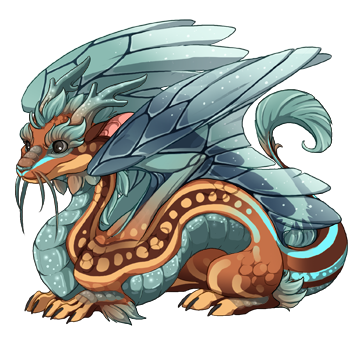
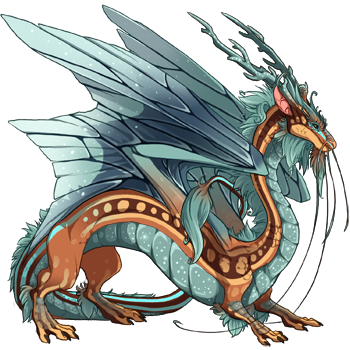
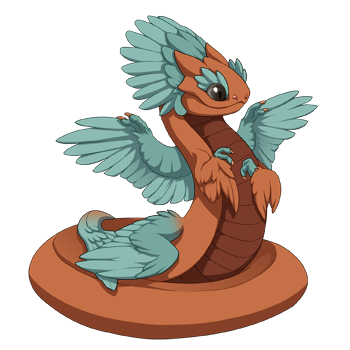
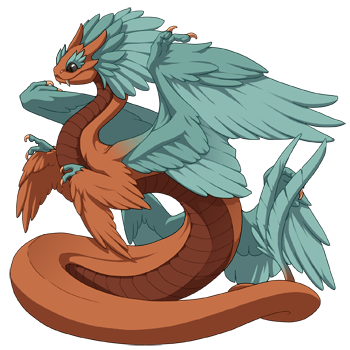
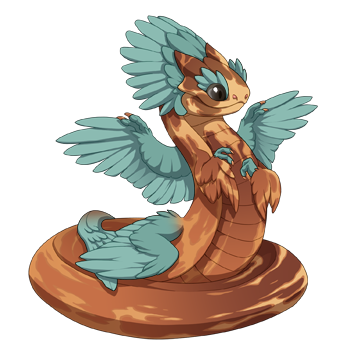
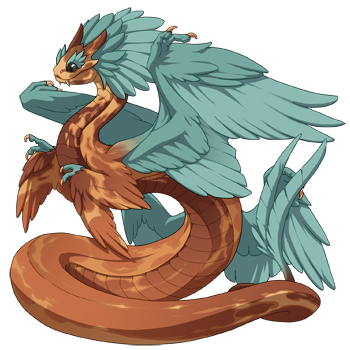
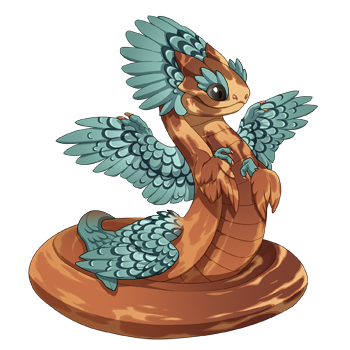
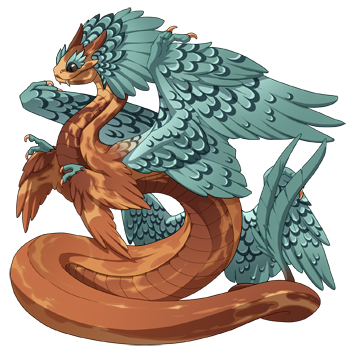
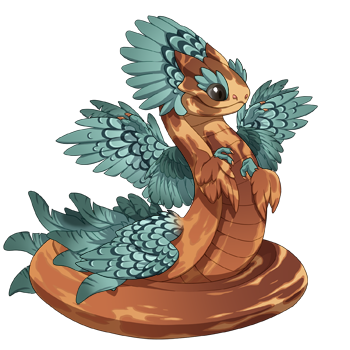
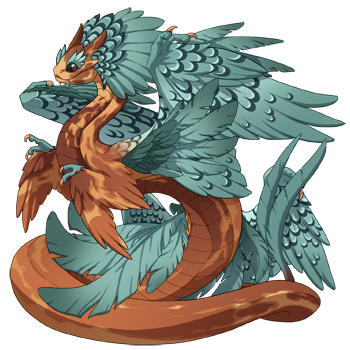
Dragon: Asplenium - Imperial Auraboa XYY Male
(Auraboa scroll applied on 2023-11-23)
(Varnish scroll applied on 2023-11-23)
(Edged scroll applied on 2023-11-23)
(Plumage scroll applied on 2023-11-23)
Purchased For: 100 gems
Hatched On: 2023-09-19
ID: 89215075
Parentage: Punng/Coilscar
Flight: Earth
Primary: Caramel Skink Basic Varnish
Secondary: Spruce Bee Basic Edged
Tertiary: Spruce Glimmer Basic Plumage
Eyes: Rare
Comments: Yeah, a third tree dragon pair for auraboa. I just really love plumage for leafy dragons. And the new varnish gene. And I am weak to tree dragons in particular, it's about half of why I switched from wind to nature a few years back (nature primal eyes being most of the remainder).
Asplenium are a genus of fern that sometimes have long single blades instead of the divided pinnate leaves that more commonly spring to mind when thinking of ferns. Asplenium nidus is one such fern, and it's also epiphytic (grows on trees), which seems very apt for auraboa dragons who live in the treetops.
Apparel: TBD
Familiar: Illumination Crecko
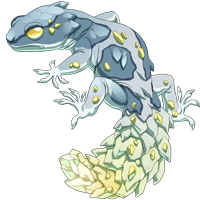
Progeny Testing:
[Test] Astelia
Broods:
Bred with Astelia on 2023-11-23, 3 eggs [Clutch]
Nested with Astelia on 2023-12-17, 3 eggs [Clutch]
Matched with Astelia on 2024-01-12, 3 eggs [Clutch]
Crossed with Astelia on 2024-02-18, 3 eggs [Clutch]
Clutched with Astelia on 2024-04-26, 1 egg [Clutch]
Mated with Astelia on 2024-07-22, 3 eggs [Clutch]
#Asplenium Dragon#Dragon Sire#Dragon Record#Asplenium Male#Asplenium Breed#Green Pool#Tree Dragon Pool#Ancient Dragons Pools#XYY#Caramel#Varnish#Varnish Caramel#Spruce#Edged#Edged Spruce#Plumage#Plumage Spruce#Earth Flight#Rare#Illumination Crecko
2 notes
·
View notes
Note
trying to translate my ocs name [thistlefiddle] into clanmew and i went with kekra for the prefix as it fits best, but i can't seem to find any words for the suffix [fiddle in this case is from fiddlehead fern]
A fiddlehead is just the young shoot of any edible fern before it unfurls! Clan cats don't have a particular word for this, because they are obligate carnivores and don't collect them for food like humans do.
Here are three words that can be used and are already in the lexicon, plus some more. Feel free to take your pick.
Fern (Generic) = Nan
Frond (Leaf of a fern) = Nanshiff
Bracken (Pteridium aquilinum) = Fofnan
Wall Rue (Asplenium ruta-muraria) = Pymwee
They aren't actually aware this is a fern, this word comes from Slate-Parsley.
Lady Fern (Athyrium filix-femina) = Namar
Describes large, grand ferns with lots of fronds, not JUST A. filix-femina. But this species is the largest in the area. It can be used as a less powerful Marssi sometimes.
NOTE: In English these are the 'lady' and 'male' ferns, but these are not gendered in Clanmew.
Man Fern (Dryopteris filix-mas) = Marssi
Very important medicinally to treat tapeworms, which is acquired from eating raw prey..... squirrelflight
Spleenwort (Asplenium trichomanes) = Norp
Another medicinal herb, grows out of cliffsides the same way that Wall Rue does.
Hartstongue (Asplenium scolopendrium) = Weskan
A huge, flat-leafed fern. The only one that doesn't have "fronds" by Clan cat standards! Comes from a corruption of "Holly-Fern."
Horsetail
And lastly! If you were wondering!!
Fernstripe = Namarseek
Lady Fern + Long, thick stripe, referencing a fern-shaped stripe that runs down her back with fronds that branch off.
Fernsong = Nanyanaya
Generic Fern + Singing, comes from the fact his kittypet name was Fiddles, which he INSISTED was some sort of fern, so they translated it as such!
Brackenfur = Fofnanfaf
Straightfoward. Bracken + Fur.
Fernshade = Weskanhorrl
Hartstongue + Understorey. Refers to Fernshade being an excellent, sneaky hunter who fares well even when there's very little cover.
Ferncloud = Marssiharryr
Man fern + fast-moving-cloud. She's called Marryr for short. Her suffix was given based on her participation in the Dog Relay Race, she runs VERY fast.
33 notes
·
View notes
Text
I just...want to work in the garden and do nothing else. Stop only to eat and pee. I go in when the daylight’s done. And then all I want to do is look at more plants I can order and talk about my garden. All my plants are native to Ontario or nearby. All with edible parts except one. So. Plant species I have/am getting this year are:
001. Achillea millefolium (common yarrow) The red-flowered cultivar seems to have died over the winter, but the non-cultivar is growing strong and is also creeping past the stone border to become one with the grass. lol
002. Actaea racemosa (black snakeroot/black cohosh) Next weekend!
003. Agastache foeniculum (anise hyssop) Literally migrated from the place I planted it to a place it likes better, I guess. As in, there is no plant where I planted, but there is an anise hyssop in another part of that bed. You do you.
004. Allium canadense (meadow garlic/Canada garlic) Spreading slowly but reliably and super tasty.
005. Allium cernuum (nodding onion) It has flowered each year--this is year 4--but hasn’t spread at all. Very tasty, and I’ve bought some friends to help it along.
006. Allium schoenoprasum (chives/wild chives) Absolutely yum and doing very well.
007. Allium stellatum (prairie onion/autumn onion) Hopefully coming by the end of this month!
008. Allium tricoccum (ramps/wild leek) It will be quite some time before it even makes flowers which hopefully let it spread, so I won’t be able to reap the benefits for a while. But, both plants did come up this year and have now died back as expected. Hopefully they’ll continue to come up.
009. Amelanchier canadensis (Canadian serviceberry) Caterpillars. Are. EATING IT. Gypsy moth caterpillars. This is going to be a problem for some time until they pupate, I guess. Plant’s generally okay, though. I won’t be getting fruit anytime soon, though.
010. Anaphalis margaritacea (pearly everlasting) Very healthy plants keeping the sunflowers under some control. This spring was my first year eating the shoots. Can’t say anything about the taste specifically, as they went into a pasta sauce, but that sauce was delicious.
011. Andromeda polifolia (bog rosemary) Next weekend!
012. Aquilegia brevistyla (smallflower columbine) Growing very well, more flowers this year. Next year I’ll eat some (flowers, only the flowers are edible).
013. Aquilegia canadensis (Canada columbine/red columbine) Flower stalk doesn’t seem as tall this year, but it still has a lot of flowers. They’re a lovely refreshing sweet snack (just the flowers).
014. Arabis alpina (alpine rockcress) Next weekend! I had one last year, but it didn’t survive the winter. The poor thing was so root-bound there was no soil in the pot, so I’m not surprised it didn’t make it. Hopefully the new one will be in better condition.
015. Arctostaphylos uva-ursi (bearberry/kinnikinnick/pinemat manzanita) Not doing great and I’m not sure why. That area is reasonably well-drained and it gets part sun, part shade. Oh well. Maybe I’ll move it to the hill in the back. It seemed to like the hill I had it on at my old apartment.
016. Argentina anserina (silverweed cinquefoil) Hopefully coming by the end of this month!
017. Arisaema triphyllum (jack-in-the-pulpit) It came up! I was sure it had died last year. But no, it’s fine. Male this year. Hopefully female next year (I’m trying to see if the berries can be dried into edibility like the corms, and if they can I want to make jam or something with them).
018. Armeria maritima (thrift sea-pink) Drooping! It’s a drought-tolerant plant that will die if over-watered so I don’t water it more than once a week and I don’t water deeply, but it’s been hot so maybe it needs more or maybe I managed to overwater it anyway. Frick. Flowering very nicely though.
019. Aronia melanocarpa (black chokeberry) Doing just fine. No flowers and I don’t expect them for another couple of years at least, but it’s growing well.
020. Artemisia frigida (prairie sagewort/fringed sagebrush) Already spreading in the bed. Should look very nice when it fills in.
021. Aruncus dioicus (bride’s feathers/goat’s beard/buck’s beard) Growing more quickly than the internet told me it would! And going to flower this year too, which will be lovely.
022. Asarum canadense (Canada ginger) Doing fine for now, but burnt a lot in the sun last year. Likely to do so again. I’m going to plant something in front of it to shade it better. See, I wouldn’t have put it there if it was full sun because it’s a shade to part sun plant, but that area isn’t full-sun, it’s part sun; however, the sunlight it does get is very strong in the summer and the poor thing gets burnt.
023. Asclepias incarnata (swamp milkweed) Growing like a beast! Flowers were gorgeous last year. I don’t expect this to be any different, and maybe some monarch butterflies will pay it a visit.
024. Asclepias ovalifolia (oval leaf milkweed/dwarf milkweed) Hopefully coming by the end of this month!
025. Asclepias syriaca (common milkweed) Mine seemed to come up much more slowly than those I’ve seen elsewhere, but it is a fairly young plant. I expect it will come up earlier next year. And it’s doing fine now.
026. Asclepias tuberosa (butterflyweed) Hasn’t come up yet, but they can take till middle of June to start emerging, so I’m not going to worry about it yet.
027. Asimina triloba (pawpaw) All three trees are alive, though with very different rates of growth. I got them at the same size at the same time, but in trying to figure out what the best thing was for them, I planted one on a hill next to the door of my at-the-time apartment, one by the fence at the opposite side of the yard, and the third I kept in a pot, which I brought in for the winter. That spring, the potted tree leafed out first at the end of April, and the one on the hill in the middle of May. The third didn’t bud at all. I continued to water it, but I was sure it was dead. Then the house my apartment was in caught fire so I had to go to a new place (same landlords, so still allowed to plant on the new property) and didn’t want to leave my plants behind. It was the end of June. All my plants were potted. and I was going to leave the lifeless stick behind AND THEN IT SUDDENLY HAD BUDS. So I potted it and took it too. All three survived the transplant, but the tree I had initially taken inside (but is now outside) is the biggest, and that little stick is still the smallest. lol
028. Asplenium trichomanes (maidenhair spleenwort) Very little still, but seems healthy. I hope for its fronds to spill over my newly constructed garden wall when it’s bigger.
029. Athyrium felix-femina (lady fern) Doing very well, as a fern that can tolerate full sun.
030. Caltha palustris (marsh marigold) It is a marsh plant and there is no pond on the property to plant it, but there is a leaking eavestrough, which I thought would do well enough along with heavy watering. So far I have been correct.
031. Campanula rotundifolia (harebell) Very lush and green. I struggled to keep it alive that first year, but three years later it’s perfect.
032. Cardamine concatenata (cutleaf toothwort) Sometime this summer!
033. Castilleja miniata (paintbrush) Sometime this summer!
034. Ceanothus americanus (New Jersey tea) Not ready to use in tisanes yet, but growing well.
035. Cerastium arvense (field chickweed) The first two years the thing was barely alive, but this year’s it’s moment to shine as it spreads and flowers.
036. Cercis canadensis (redbud) No flowers this spring, but wonderful foliage. Fingers crossed for next year.
037. Comptonia peregrina (sweetfern) Next weekend!
038. Coreopsis lanceolata (lance-leaved tickseed) The first plant I attempted died, but this one’s doing very well.
039. Cornus canadensis (bunchberry) Next weekend! I mean, my plant from last year would likely be fine if the squirrels hadn’t dug it up, as would the one before that (because that one came from the old place and had survived the winter just fine!). So, I’m going to plant the new one in a different spot and hope the fluffy-tailed rodents leave the poor thing alone this time.
040. Cornus florida (flowering dogwood) Just a baby still, but its leaves are nice and green. I had one before it that really liked the hill I had planted it on back at the old place but died in the pot before I could put it in its new home.
041. Cystopteris bulbifera (berry bladder fern) Doing just fine. I love my ferns.
042. Dalea purpurea (purple prairie clover) Hopefully coming by the end of this month!
043. Deschampsia caespitosa (tufted hair grass) Not doing too well. Was fine last year, so I’m not sure what’s going on.
044. Echinacea purpurea (purple coneflower) I’ve always loved these. They’re edible, medicinal (with caution), have lovely flowers, and attract lots of pollinators including bees and butterflies. Mine is doing perfectly. No flowers yet this year, but very green healthy foliage.
046 Erythronium americanum (trout lily/dogtooth violet) Still no flowers this spring, but they did come up, so maybe next year.
047. Eupatorium purpureum (sweet-scented Joe Pye weed/gravel root/purple Joe Pye weed) Soon! Also, do you know how this is eaten? Its root is literally burnt and then you use the ashes to flavour your food. The plant is otherwise poisonous, so how it was found out that it could be used this way conjures up amusing scenarios for me.
048. Fragaria vesca (woodland strawberry/wild strawberry/alpine strawberry) I have strawberries! They’re far from ripe yet, but developing well. They’re also spreading over the hill I planted them on and will hopefully give the garlic mustard and dog-strangling vine a run for their money.
049. Fragaria virginiana (wild strawberry/Virginia strawberry/common strawberry/mountain strawberry) Because one native species of strawberry isn’t enough, I have both. This one is also making strawberries and nicely filling out the area I put it in.
050. Galium boreale (northern bedstraw) Newly planted! The first one of these I planted didn’t survive the winter, but I hadn’t been able to plant it until autumn (because I hadn’t yet been told where I could plant). This one has the rest of spring, the whole summer, and fall until frost to establish itself, and I’ve seen a number of them growing wild at the edge of the ravines, so it should be fine.
051. Gaultheria procumbens (American wintergreen/eastern teaberry/boxberry/checkerberry) Next weekend! I actually already have one and have had it for a couple years, but it’s another that came so root-bound there wasn’t any soil in the pot. I planted it hoping for the best, but it seems to be in a very slow decline. So I’m going to plant another one, hopefully not so root-bound and that will maybe either give it a boost (plants of the same species will often help each other when sick by transferring nutrients) or else take over when the first one dies.
052. Geum aleppicum (yellow avens) I didn’t plant this, and I can’t find it for sale anywhere anyway, but it’s a common plant that shows up as a weed. Being native as well as edible, it’s allowed to stay wherever it isn’t directly in my way.
053. Geum canadense (white avens) Same as above. lol Anyway, both species have attractive foliage. They’re likely not used as garden plants because of how common they are as weeds and because their flower stalks are long and leggy. But I’m happy to have them.
054. Geum rivale (purple avens) Newly planted! This one is offered as a garden plant, though fairly rare, and I’ve finally got my hands on one! All of the Geum species in my garden seem to be doing just fine, so I expect this will fine too. It’s the first plant I’ve put in a new area that doesn’t drain very well which makes it perfect for plants like this one that grow in clay on stream banks.
055. Geum triflorum (prairie smoke) Green leaves. Flower stalks up. This is a pretty reliable plant because it doesn’t die back in the winter, it just sort of sits there waiting for spring and then resumes growth like nothing happened. The first year it drooped a lot but once it established itself there was no stopping it and the transplant went smoothly too.
056. Grindelia squarrosa (gumweed) Hopefully coming by the end of this month!
057. Helianthus divaricatus (woodland sunflower) This is a sunflower that can actually stand a fair bit of shade. I thought mine had died last year due to the foliage and stemming dying back after a squirrel broke it and it and it was still summer. But it’s come up this year and I’m starting to think nothing short of cooking a sunflower’s roots will actually kill it.
058 and 059. Helianthus nuttalli (Nuttall’s sunflower/common tall sunflower) and Helianthus pauciflorus (stiff sunflower/beautiful sunflower) All I know is, I ordered both, I received two small plants, by the time I got them in the ground they were barely alive, that area is now being overtaken by sunflowers, and it could be one species, or it could be both, I don’t know. I did thin out some shoots this spring and add them to a very flavourful pasta sauce. I also thinned out a bunch of their roots last fall. To look at them, you wouldn’t know that either of these had happened, and I’m going to have to thin out more. They’re also putting up shoots between the stones of the cement path. There will be sunflowers here until the end of time.
060. Helianthus tuberosus (sunchoke/Jerusalem artichoke/suntato) Because I don’t learn, I planted yet another sunflower species last year, in a different area, because dammit I want my suntatoes that taste like artichokes. I planted one last year. I took and ate a bunch of tubers in the fall. There are currently five plants. This should be interesting.
061. Heliopsis helianthoides (false sunflower/sweet oxeye) After getting off to a rocky start last year, this one’s doing just fine, and also looks to be living up to its resemblance to sunflowers in more than just appearance.
062. Hibiscus moscheutos (swamp rose mallow) One of them appears to have died so I hope the other isn’t headed the same direction. Seems to be coming up normally though. Also I learned the flowers can change colour from year to year which was a huge surprise to me from the first year to the second. No idea what it will be like this year.
063. Hierochloe odorata (sweet grass/vanilla grass) It flowered last year, which was lovely. I hope it does so again this year. Foliage is nice and green anyhow.
064. Humulus lupulus (common hop) Growing nicely now, though its first several shoots died this year. It seems to just be a very impatient plant in the springtime despite not being very frost hardy. So it put out shoots, which died in the frost, and then put out more, which also died, etc. until finally there was no more frost so it just kept growing. That’s one way to do it, I guess. lol Most other frost-tender plants tend to be more cautious about when they put out new growth. had a hop plant at my old apartment, which really liked the place I put I put it in, but it died when I potted it to try and take with me.
065. Impatiens capensis (jewelweed/spotted touch-me-not) Hopefully coming by the end of this month!
066. Juglans nigra (black walnut) This tree has likely been on this property since before I was born. I tapped it spring before last. I’ll tap it next spring too. Seems to be a healthy tree.
067. Kalmia latifolia (mountain laurel) They’re not native to Ontario but they are native to eastern North America, in the Appalachian mountains. I figured if they could survive mountain weather they could handle south Ontario winters, and so far it has. It’s not edible but I fell in love with them a long time ago when reading David Attenborough’s The Secret Life of Plants. And they’re making buds this year!
068. Lactuca canadensis (Canadian lettuce) Yes! We have a native lettuce. Most people will pull it up as a weed along with dandelions and thistles, though. I let it stay wherever possible. It’s not like I can just buy a new one, so I count myself lucky when they come up in my garden.
069. Lilium michiganense (Michigan lily) It made smaller ones, but they don’t seem to have survived for whatever reason. The older ones are very robust this year, though, and are budding with what looks like will be many flowers.
070. Lilium philadelphicum (wood lily) Newly planted! I have not had much luck with these, but hopefully this year’s the year. I have two plants, so maybe they’ll help each other.
071. Lindera benzoin (spicebush) No flowers or butterflies yet, but it’s a healthy bush and lives up to its name.
072. Linum lewisii (blue flax) Newly planted! I’ve wanted these for a long time but the places that carried them either wouldn’t deliver or didn’t have them as plugs or potted stock (I find seeds too unreliable). But now I have a couple in the large stone garden pot that I specifically filled with dirt that would allow for good drainage, for those plants that can survive the cold but not sitting in water.
073. Lupinus perennis (sundial lupine) Soon! Or I already have it. Not sure. See, I was sent an email by the company saying I’d probably accidentally gotten a bigleaf lupine instead and they gave me a coupon for the following spring to get a confirmed sundial lupine, but there is a chance I already have it. Either way it’s a nice plant, so whether I have two plants of the same species or two different species is fine.
074. Lupinus polyphyllus (bigleaf lupine/common lupine) I actually haven’t been able to find this species available for delivery anywhere, so if that is what I currently have, then I’m delighted and this is the best plant mixup that could possibly happen (there have been a number). Whatever it is is a very attractive plant even with just the foliage. I hope it makes flowers this year.
075. Mahonia repens (creeping Oregon grape) Speaking of plant mixups! The first time I ordered this I got a Potentilla nepalensis instead. I didn’t know it at the time, as it had a tag saying “Mahonia repens”, but then it flowered...I wouldn’t have minded terribly much if it had been a native Potentilla species, but “nepalensis” is definitely not that. Well, I emailed the company with a photo and they promptly delivered not one, but two creeping Oregon grape plants, and both seem to be doing okay, making new growth, survived the winter, which the potentilla did not.
076. Maianthemum stellatum (starry false Solomon’s seal) They seem to be doing well! They flowered, but I don’t know if there will be berries. Next year maybe, but then you don’t really see Maianthemum berries until late summer, so maybe there will be a couple this year.
077. Mentha arvensis (wild mint) It’s doing exactly what mint does. Tastes wonderful, which is a great reason for thinning it out and pulling it out from between the sidewalk stones.
078. Mertensia paniculata (tall bluebells) Currently flowering. Despite the name, though they do grow taller than their cousin the Virginia bluebells, I wouldn’t say they’re a bigger plant overall. Very nice though. The flowers are a delicate light blue.
079. Mertensia virginica (Virginia bluebells) When I planted the rootstock in the early summer and nothing came up at all, I thought they had died. But nope! They came up vigorously this spring, with huge leaves and incredibly blue flowers. The flowers are don and it’s starting to die back now, but what a gorgeous springtime plant it is.
080. Monarda didyma (scarlet beebalm) My theory is if you put two members of the mint family next to each other, they’ll keep each other at bay. I’m probably wrong. Anyway, this is already spreading in two directions. Last year caterpillars at a lot of its flowers. I hope that won’t happen this year.
081. Monarda fistulosa (wild bergamot) Has become a very big plant, but politely hasn’t really left it’s immediate area. They make great dried flowers after the winter, by the way, as the seedheads retain the scent. Especially if you squeeze them.
082. Monarda punctata (horsemint) This is starting to fill out now, but compared to the other members of its genus took a very long time to go past a teeny tiny little growth. Last year it got huge shortly after I planted it, so we’ll see if it does that this year. I hope so. The bees, wasps, and other pollinators absolutely loved it.
083. Myosotis laxa (smallflower forget-me-not) I didn’t plant it, I can’t even find it available for sale. It just grows as a weed. It’s just as blue as other forget-me-nots, but with stems that are very leggy and even smaller flowers than the popular garden species. But it’s native so it stays where it’s not directly in my way. It’s very prolific, lots of plants in the garden.
084. Myrica gale (sweet gale/bog myrtle) Only just started making new growth. It seems to be on its way out and I’m not sure why, but it makes me sad. I think last year was really hard on it being so hot so early and I didn’t have a hose then, so I was stuck carrying buckets of water up from my apartment in the basement. But I have a hose this year and I’ve been watering regularly, so maybe, just maybe, it will spring back into action this year. It’s such a pretty bush when in full foliage and the leaves taste like green tea.
085. Oenothera fruticosa (narrow-leaved sundrops) Next weekend! I’ve grown another species which has finished its lifecycle (they’re biennial) and sadly doesn’t seem to have successfully reseeded itself. But maybe this one will.
086. Onoclea sensibilis (sensitive fern) This poor thing struggled hard last year. I planted it between a tree and the house, but it still got a lot of sunlight. Still, it came up this year, and in my experience, second year plants tend to be much more hardy, so we’ll see. It’s doing fine for now.
087. Opuntia fragilis (fragile prickly pear) I did put it in a fairly dry area that gets full sun, but it does struggle in the winter and spring. It is starting to bounce back, though, just like it did last year, and the pieces it scattered are making roots of their own. All of whom are spiky bastards.
088. Opuntia humifusa (eastern prickly pear/devil’s tongue) This did just fine. I had it in a big stone pot which I moved to an area that gets no rain or snow on it, and it’s making new growth now that I’ve moved the pot back into the full sun. It like to spike me whenever I move the pot.
089. Osmundastrum cinnamomeum (cinnamon fern) Next weekend!
090. Oxalis stricta (yellow woodsorrel/sourgrass) It’s not technically native to Ontario, but it is native to Michigan and moved up here decades or possibly centuries ago. I didn’t plant it and you can’t find it in stores because it’s considered a weed, but it is coming up in my garden, it doesn’t hurt anything, and it is a delicious little plant, so it stays.
091. Parthenocissus quinquefolia (Virginia creeper) I didn’t have to buy this because it was already in the yard (it’s common in the ravines), but if it wasn’t I would have, because it’s gorgeous and I like the taste of the berries. It’s a native relative of Boston ivy, so if you’re wanting a wall climber, please get Virginia creeper instead. They’re available at a lot of garden centres and online.
092. Phlox divaricata (woodland phlox/blue phlox) It’s growing, but I think one of the white avens is overcrowding it, so I’ll probably dig that one up and eat it so the phlox can have more space.
093. Podophyllum peltatum (mayapple) Three plants in last year. One plant up this year. Oh well. It’s growing nicely, so hopefully it will spread.
094. Polygonatum biflorum (smooth Solomon’s seal) Hopefully coming by the end of this month!
095. Polystichum achrosticoides (Christmas fern) It doesn’t die back in the winter! I mean, the leaves get kind of yellowed, but otherwise just hangs out and makes new growth in spring. My first attempt with ferns (ostrich ferns) was a failure, but so far all my other fern species have been successful and are currently thriving.
096. Prunus americana (American plum) It’s very top heavy when leafed so it flops over whenever it rains which is kind of funny, but it seems to be doing fine.
097. Prunus nigra (black plum/Canada plum) My first black plum died, but this one seems fine.
098. Prunus pumila (sand cherry) Soon! And it better bloody be a sand cherry and not a purple-leaf sandcherry, which is a hybrid, like the last company I ordered one from sent me. But that company didn’t specialize in native plants and carried both plants, whereas this company does specialize in native plants and does not advertise the hybrid at all.
099. Prunus serotina (black cherry) This is the very cherry that is used to flavour black cherry ice cream! But my little tree (not that little anymore lmao) hasn’t made flowers yet. It has nice foliage though it keeps trying to grow into the neighbour’s fence. Don’t know why. The sun doesn’t come from there. Maybe it will flower next spring.
100. Pycnanthemum tenufolium (slender mountain mint) Despite being part of the mint family, this is actually a very polite plant so far that stays in its immediate area.
101. Pycnanthemum virginiana (Virginia mountain mint) Just as polite as its cousin. My first died and I blame the person who lived in another unit who decided that garden bed was an ash tray. I managed to put a stop to that, got all the cigarettes out, dug out a stump, added new dirt, and planted a new Virginia mountain mint as well as bride’s feathers. That particular tenant isn’t there anymore and nobody else does anything with the outside, except to put a garden hyacinth there, which I’ve left in its pot and been watering. I’m not just going to leave the poor thing to die. Anyway, the Virginia mountain mint flowered last year and I hope it does so again this year.
102. Ratibida columnifera (yellow coneflower/upright prairie coneflower) Newly planted! I don’t like to get the cultivar versions if I can avoid it, but I will if that’s all that’s available, or in this case, to get the plants I really wanted, I needed to get something that would put me over the minimum cost. But I didn’t want to leave it at that, so I bought a non-cultivar this year so they can be friends.
103. Ratibida pinnata (gray-headed coneflower/yellow coneflower/pinnate prairie coneflower) This almost flowered last year and the I accidentally broke it with the hose. That will not happen this year. I don’t see a flower stalk yet, but the leaves look healthy.
104. Rhus aromatica (fragrant sumac) It’s putting out flowers, but it did so last year and nothing happened, so I guess we’ll see this year.
105. Rosa blanda (smooth rose) A rose without thorns! Or almost. It’s got leaves out, but it’s a slow grower for a rose and hasn’t flowered yet.
106. Rubus occidentalis (black raspberry) This was supposed to be a red raspberry because black raspberries are easy to find in the ravines, but that’s okay, and I did order a new red raspberry which will hopefully actually be red. lol
107. Rubus strigosus (American red raspberry) Soon! Sometimes considered a variety of Rubus idaeus, which is the one you find in grocery stores. There is one patch I’ve found of them in the ravines, but they’re not nearly as common here as the black raspberry. Hopefully this new plant I get will actually be the red raspberry.
108. Rudbeckia laciniata (cutleaf coneflower/green-headed coneflower) There are two plants with very different leaves growing there. One of them I hope is the plant I intended, but won’t know until they flowers. They’re both doing well, whatever they are.
109. Sambucus canadensis (common elderberry) It’s making flowers this year! I learned the hard way that this species does NOT like being transplanted to a pot, which I had to do to take with me to my current apartment. However, it did eventually bounce back and didn’t mind being transplanted to its current location, which it likes just fine.
110. Shepherdia canadensis (Canada buffaloberry) Next weekend!
111. Solidago canadensis (Canadian goldenrod) I tried to buy this plant but they accidentally sent me an aster species instead. However, there are a bunch of goldenrods growing a different area that I didn’t plant and I believe to be this species.
112. Solidago nemoralis (gray goldenrod) Droops a lot but bounces back quickly.
113. Solidago simplex (spike goldenrod/sticky goldenrod/Mt. Albert Goldenrod) I’ve tried this once before and it died, possibly from being small enough that the ledge it was next to prevented it from getting enough sunlight. I’ve planted the new one far enough from the ledge that it does not get shaded by it, so hopefully that will do the trick.
114. Spiraea alba (meadowsweet) The first year in the new place it struggled a bit, but it’s fine now and it flowered last year.
115. Symphoricarpos orbiculatus (coralberry) Next weekend! It’s also the first time I’ve seen it available anywhere.
116. Symphyotrichum ciliolatum (fringed blue aster/Lindley’s aster/northern heart-leaved aster) A very polite aster, or maybe it’s just being kept under control by the sweet grass (055). Its foliage is that lovely gray-green colour often referred to as “blue” when people talk about holly, spruce, and hosta leaves, and its flowers are that pale blue people often think of as purple or periwinkle but shows up digitally as light blue.
117. Symphyotrichum cordifolium (heart-leaved aster) Doing fine where I planted it.
118. Symphyotrichum laeve (smooth aster) I didn’t have the tag and thought this was a violet when I planted it. It now thinks it owns the space, but looks very nice when it’s in bloom.
119. Symphyotrichum lanceolatum (panicled aster/lance-leaf aster/willow aster/tall white aster/eastern line aster/white-panicle aster/narrow-leaf Michaelmas daisy) Lots of common names. It decided it belonged on the sidewalk last year, but surprisingly agreed when I placed its branches behind the stone line of the garden. We’ll see if we can come to the same agreement this year.
120. Symphyotrichum novae-angliae (New England aster) Not flowering yet this year, but looks it’s getting ready. They’re such a lovely rich violet to purple and I love that they flower so late into autumn too.
121. Taraxacum officinale ceratophorum (fleshy dandelion/horned dandelion/rough dandelion) Obviously didn’t buy it. lol But it is in my garden along with non-native subspecies. Since they don’t harm the plants they grow among, they can stay as long as they’re not in my way.
122. Trillium erectum (red trillium) Next weekend! And I possibly already have one. See, I ordered three trillium species last year as bulbs and planted them, but lost two of the tags. Only two species came up and only the one with the tag flowered this year. So I don’t know if the one that didn’t flower was erectum or grandifolium, so I ordered both again.
123. Trillium flexipes (nodding trillium) It came up this year and it was lovely. Died back now though.
124. Trillium grandiflorum (great white trillium) Next weekend! And I might already have one: see 109. Ontario’s provincial flower. I once made a set of coat of arms style designs with each of the provincial flowers and animals.
125. Urtica dioica gracilis (stinging nettle) Planted itself in my garden back at the old place and if I didn’t trust the other plants would be safe after I left (I was right, by the way; the whole backyard has been turned over) I definitely didn’t think this would be either, so I potted it to take with and got stung for my trouble, but it’s happy in its new home. Lives up to its name, of course, but I did eat a few of the tops earlier this year in soup and later in pasta sauce, so I suppose we’re even.
126. Vaccinium angustifolium (lowbush blueberry/wild blueberry) When you see “wild blueberries” in the grocery store in Ontario, it’s this. It always seems to struggle with mould in the spring. Every year I’ve had it. I got it a friend in hopes it would help, but they seem to both be dealing with it now. I’ll have cut back the bad branches and hope that helps. It usually does, but I don’t know why it starts in the first place. None of the neighbouring plants are suffering.
127. Vaccinium corymbosom (highbush blueberry) This is the species you’ll most often see in the grocery store in Ontario as “blueberries”. My bush always makes some flowers and berries, but it’s not doing great right now. Not sure why. It doesn’t get mould the way the lowbush blueberries do. I hope it’s not on its way out. You can get them at a lot of garden centres, but there’s usually a minimum amount of plants or a minimum cost, and garden centres that specialize in native plants don’t often carry these, while garden centres that don’t often don’t have any other native species or at least not any I need or have room for. So for my purposes they’re kind of hard to get.
128. Verbena hastata (blue vervain) Was off to a slow start this year, but it’s doing just fine now.
129. Viburnum acerifolium (mapleleaf viburnum) Next weekend!
130. Viburnum lentago (nannyberry) It’s doing fine, just fine, but I doubt I’ll get any berries for some time yet.
131. Viburnum nudum cassinoides (Witherod viburnum) A lovely little bush so far. Maybe I’ll get flowers next spring.
132. Viola adunca (hookedspur violet/western dog violet/early blue violet) Hopefully coming by the end of this month! My first go with this plant was not successful. Hopefully better luck this time.
133. Viola blanda (sweet white violet) Exactly what it says on the tin. There’s a delicate pink to the centre, and the foliage is nice too.
134. Viola canadensis (Canada violet) It’s tall for a violet, and spreading nicely with lots of flowers.
135. Viola labradorica (purple Labrador violet) Next weekend! Despite it’s name, it is also native to Ontario.
136. Viola sororia (wood violet/blue violet) This is most common violet you see generally, which makes it hard, though not impossible, to find in garden centres. However, they’ve planted themselves in the yard and I’ve successfully transferred one to one of the beds. I have other place I want to put the rest before I dig up that area.
137. Vitis riparia (riverbank grape) I have two plants because I didn’t realize when I bought it that hiding among the weeds in another part of the garden there already was one. Oh well. Guaranteed cross-pollination of two genetically diverse individuals. They’re both doing well.
138. Zizia aurea (golden alexanders) They’re doing well. It looks a lot like wild parsnip, which it is related to, but it’s much more friendly, and I ate some this spring.
I may be able to order more. We’ll see. One of my go-to places says they won’t ship until “opening day”. I guess they mean when their area reopens, but that might not be till next year. Meantime, I will continue to construct my garden wall in the back.
32 notes
·
View notes
Text
Ferns
I’m really getting into the gardening at the moment for some reason. Things that previously seemed dauntingly impossible are now perfectly fine. Hopefully when I get an area cleaned up I can post a picture.
The thing I’m doing right now is getting the ferns identified and then learning about them. Most, perhaps all, are self-seeded (self-spored).
There appear to be 3 native types:
Polystichum vestitum - Prickly Shield Fern/Pūniu
Cranfillia fluviatilis - Creek Fern/Kiwakiwa
Asplenium gracillimum - Hen and Chickens Fern/Mouku
And 2 foreign types - although these are very similar and I’m not sure if I really have both or just one. One is invasive, and other not so bad but still a pest. I’ll be pulling these out when I have something to replace them with (don’t want to remove all the pests straight away because they’re supporting the banks and preventing erosion).
Dryopteris filix-mas - Male Fern
Dryopteris affinis - Scaly Male Fern
I also bought a couple to put in, so hopefully will have a small collection of native ferns :)
Fun fact: when I was younger I thought only Pacific countries had ferns. Was shocked to discover ENGLAND of all places had ferns. WTF. Shocked later on that some of the common ferns I saw in NZ were actually invasive species. How could ferns betray me like that?
2 notes
·
View notes
Text
26 October - 13 November 2020
These past few weeks have been an emotional roller-coaster. Back in September several friends, within 48 hours of each other, informed me about an amazing opportunity in the south of France. I was so touched that people were looking out for me, knowing I’ve been aching to move to somewhere warmer, more Mediterranean. I hesitated for a week because the job announcement on a garden designer’s Facebook page stated French was important. I’ve studied French for a long time and I still have a long way to go to fluency. Again, later in the week, another friend from Kew mentioned it and knew the garden personally.
So I took the plunge and sent my CV, in French, to the garden designers. They liked it well enough to pass it to the client. A week later I had my first phone interview and it went well. Now I was super excited and could hardly sleep. On paper this job sounds really good. I checked out some You Tube videos on the garden designer, their preferred maintenance contractor and the nursery they use. I only became more interested and excited.
Plant ident 30 October
Lamiaceae Salvia africana-lutea syn. of Salvia aurea
Lamiaceae Salvia canariensis
Lamiaceae Salvia confertiflora
Lamiaceae Salvia elegans ‘Honey Melon’
Lamiaceae Salvia greggii x serpyllifolia
Lamiaceae Salvia greggii ‘Stormy Pink’
Lamiaceae Salvia involucrata
Lamiaceae Salvia microphylla var. neurepia ‘Oxford’
Lamiaceae Salvia ‘Nel’
Lamiaceae Salvia ‘Phyllis Fancy’
Plant of the week
Lamiaceae Salvia confertiflora Pohl
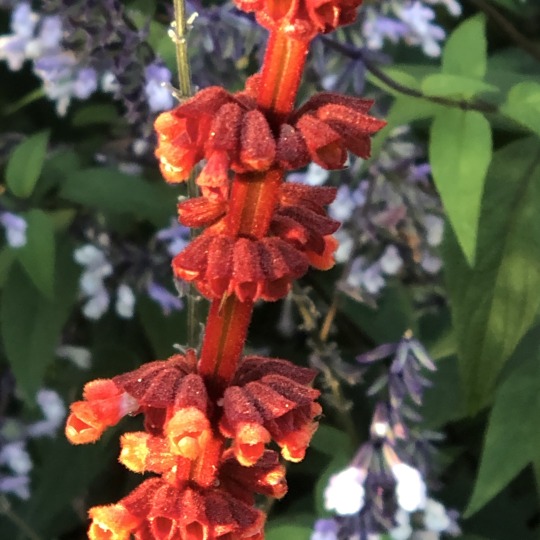
common name(s) - Sabra spike sage
synonym(s) - Salvia confertiflora var. angustifolia J.A.Schmidt; Salvia confertiflora var. brachyantha Pohl; Salvia rufa Epling
conservation rating - none
native to - Brazil
location - salvia walk, accession 2019-0398
leaves - deciduous, pungently-scented, ovate
flowers - slender spikes of small scarlet flowers, covered with velvety red-brown hairs, with the stems of the inflorescence and the calyx also having a red-brown colour, in late summer and autumn
habit - a tender bushy perennial to 1.2m tall, becoming woody at the base
habitat - tropical, summer rains, dry winters
pests - slugs, snails, capsid bug, rosemary beetle, leafhoppers
disease - generally disease-free
hardiness - to 1ºC (H2)
soil - loam, chalk or sand, well-drained
sun - full sun, sheltered
propagation - seed in containers in a cold frame in spring; softwood cuttings in spring or early summer or semi-ripe cuttings in late summer or autumn with bottom heat
pruning - cut down if hit by frost
nomenclature - Lamiaceae - lamium - gullet, the name in Pliny refers to the gaping mouth of the corolla; Salvia - healer, the old Latin name for sage with medicinal properties; confertiflora - with dense or crowded flowers
NB - first discovered in 1833 by the Austrian naturalist, Johann Baptist Emanuel Pohl in the Serra dos Órgãos, state of Rio de Janeiro. Pohl sent specimens back to botanical gardens of Europe where it was popular not only for its dramatic colour, but also for its prolific flowering well up to the time of frost
References, bibliography:
Gledhill, David, (2008) “The Names of Plants”, fourth edition; Cambridge University Press; ISBN: 978-0-52168-553-5
IUCN [online] http://www.iucnredlist.org/search [18 Nov 20]
Plant List, The [online] http://www.theplantlist.org/tpl1.1/record/kew-182420 [18 Nov 20]
Plants of the World [online] http://plantsoftheworldonline.org/taxon/urn:lsid:ipni.org:names:456011-1 [18 Nov 20]
Royal Horticultural Society [online] https://www.rhs.org.uk/Plants/16324/i-Salvia-confertiflora-i/Details [18 Nov 20]
Wikipedia [online] https://en.wikipedia.org/wiki/Salvia_confertiflora [18 Nov 20]
About ten days later I received an email inviting me to meet with his wife, here in London, for a second interview. That took place one evening after work. Again, the conversation went very well and it turns out we have a friend in common - who would have imagined!
The following week, after posting some tea to my sister in LA, I received the call offering me the position. Again, no sleep that night!
While all of this was happening, my tinnitus has been acting up too. I have also experienced a few bouts of vertigo, which is quite rare for me.
So that Friday, two weeks ago, I tendered my resignation. I asked to take my remaining annual leave as part of my notice period which meant I only had two weeks left in the garden. This will give me next week to sort my packing and I’ll fly to Nice next Saturday, 21 November. This will give me one week to work with the person who is leaving. I’ve never had such a fantastic opportunity for a week-long hand-over.
Plant ident 6 November this week was a review of the past four weeks, those were my favourites at Kew because it helped me retain names that would otherwise have just never stuck.
Plant of the week
Cucurbitaceae Momordica charantia L.

common name(s) - bitter melon; bitter apple; bitter gourd; bitter squash; balsam-pear
synonym(s) - Cucumis argyi H.Lév.; Cucumis intermedius M.Roem.; Momordica charantia subsp. abbreviata (Ser.) Greb.; Momordica charantia f. abbreviata (Ser.) W.J.de Wilde & Duyfjes; Momordica charantia var. abbreviata Ser.; Momordica charantia var. longirostrata Cogn.; Momordica charantia var. muricata (Willd.) Chakrav.; Momordica chinensis Spreng.; Momordica elegans Salisb.; Momordica indica L.; Momordica muricata Willd.; Momordica sinensis Spreng.; Momordica thollonii Cogn.; Sicyos fauriei H. Lév.
conservation rating - none
native to - tropical and subtropical Old World
location - tropical corridor, accession 2020-0110
leaves - simple, alternate leaves 40 to 120mm across, with three to seven deeply separated lobes
flowers - separate yellow male and female flowers; in the Northern Hemisphere, flowering occurs during June to July and fruiting during September to November
habit - very vigorous, tendril-bearing vine to 5m
habitat - hot humid areas of the tropics and subtropics; savannah and bush; common in coastal thickets, along creeks and streams, and in lowland forest margins
pests - aphids
disease - downy mildew, powdery mildew, Fusarium wilt, target leaf spot, root-knot
hardiness - to 5ºC (H1c)
soil - rich in organic matter with 2m to 2.5m of rainfall annually
sun - full sun
propagation - seed - sow in situ; seedlings emerge five to seven days after sowing, but fresh seed often shows dormancy which is very hard to break and can last for some months
pruning - none
nomenclature - Cucurbitaceae - cucurbita - Latin name for the bottle-gourd; Momordica - bitten, the jagged seeds of balsam pear appear to have been nibbled; charantia - graceful, the pendent fruits
NB - is a laxative, diuretic herb that soothes irritated tissue, lowers fevers, kills parasites and cleanses toxins from the system; probably also a uterine stimulant; the fruit is most often eaten green, or as it is beginning to turn yellow. At this stage, the fruit's flesh is crunchy and watery in texture, similar to cucumber, chayote or green bell pepper, but bitter. The skin is tender and edible.
References, bibliography:
Gledhill, David, (2008) “The Names of Plants”, fourth edition; Cambridge University Press; ISBN: 978-0-52168-553-5
IUCN [online] http://www.iucnredlist.org/search [20 Nov 20]
Plant List, The [online] http://www.theplantlist.org/tpl1.1/record/kew-2372864 [20 Nov 20]
Plants of the World [online] http://plantsoftheworldonline.org/taxon/urn:lsid:ipni.org:names:293413-1 [20 Nov 20]
Useful Tropical Plants [online] http://tropical.theferns.info/viewtropical.php?id=Momordica+charantia [20 Nov 20]
Wikipedia [online] https://en.wikipedia.org/wiki/Momordica_charantia [20 Nov 20]
I worked the weekend of 7/8 November, my last weekend duty.
I’ve been taking private French lessons twice a week for the past three weeks. François has been taking an hour out every weekend to help me with my French. I’m hoping once I start living in the language it will come together. Lucien organised my French mobile number, so it will be ready to use when I land.
During these few weeks in the garden leaves have been falling and falling and falling. Al spends most mornings blowing leaves into big piles. He’s also agreed to stay on through the end of January.
Plant ident 13 November ferns
Aspleniaceae Asplenium trichomanes
Aspleniaceae Asplenium scolopendrium
Blechnaceae Blechnum cordatum
Dennstaedtiaceae Pteridium aquilinum
Dicksoniaceae Balantium antarcticum syn. Dicksonia antarctica
Dryopteridaceae Polystichum setiferum
Polypodiaceae Adiantum venustum
Polypodiaceae Microsorum diversifolium syn. Phymatosorus pustulatus subsp. pustulatus
Polypodiaceae Polypodium interjectum
Pteridaceae Coniogramme emeiensis
I gave Olivia a thorough hand-over of my beloved tropical glasshouse. I’m sure it is in good hands, and under the always watchful eye of Jess.
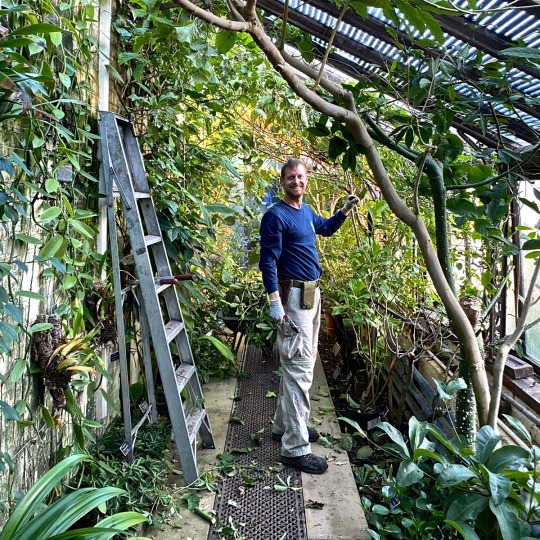
Jess and I gave the tropical corridor it’s winter pruning on Thursday.
Nell has allowed me to work on several projects on the database I’ve been trying to complete. I added to my predecessor’s manual for the plant records manager. It is quite comprehensive. I hope my replacement finds it helpful and continues to update it as the roll changes.
Wednesday, when Jill was in the garden, I asked her to create a herbarium specimen of the Romneya coulteri for me, also being a California native.

Friday, 13 November, saying goodbye... I made my way to Victoria in the morning, before work, to purchase one last social from Ole & Steen. After work we indulged in cheese, beers and Nell gave a very nice speech.
Mary Ellen painted this for me, and the plant and secateurs were gifts from colleagues.

The evening concluded with a stint in the jacuzzi - so very relaxing.

Plant of the week - a foreshadow of the next garden in which I shall be working
Cistaceae Cistus creticus L.
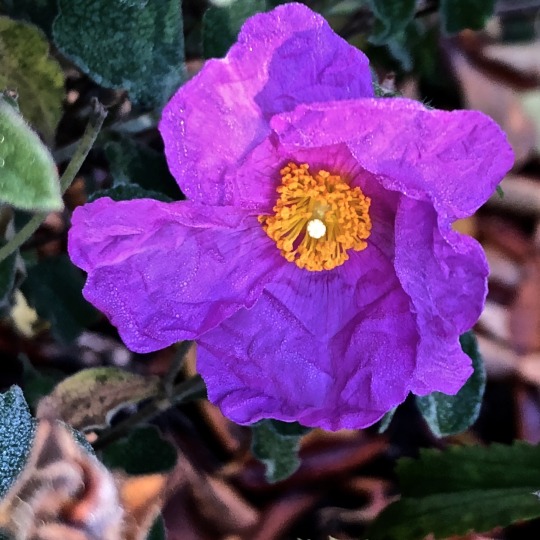
common name(s) - Cretan rockrose
synonym(s) - Cistus complicatus Spruner ex Nyman; C. creticus f. albus (O.E.Warb.) Demoly; C. creticus f. flavus Demoly; C. creticus subsp. trabutii (Maire) Dobignard; C. cupanianus C.Presl; C. dunalianus Sweet; C. garganicus Ten.; C. × incanus subsp. creticus (L.) Heywood; C. incanus subsp. creticus (L.) Heyw.; C. ladaniferus Stokes; C. polymorphus Willk.; C. rotundifolius Sweet; C. tomentosus Lam. [Illegitimate]; C. undulatus Moench; C. villosus L.; C. villosus f. albus O.E.Warb.; C. villosus var. creticus (L.) Boiss.; C. villosus var. rotundifolius (Sweet) Grosser; C. villosus var. trabutii Maire; C. villosus var. undulatus Grosser; C. vulgaris Spach; Ladanium officinarum Spach; Ladanum verum Raf.
infraspecific taxa - Cistus creticus subsp. corsicus (Loisel.) Greuter & Burdet; Cistus creticus subsp. eriocephalus (Viv.) Greuter & Burdet
conservation rating - none
native to - central and eastern European Mediterranean to Jordan
location - history beds, accession 1996-0376
leaves - shaggily hairy stems, leaves are slightly scented
flowers - variable in shade from deep purple-pink to rose pink, to 6cm across, with a yellow centre
habit - very variable, small, bushy, evergreen shrub, to perhaps 1.5m tall; highly branched shrub that measures between 30 to 140 cm with a more or less creeping stem but without actually taking root in the ground, with little strength to stay upright
habitat - distributed in calcareous romerales that inhabit soils with sandy characteristics; can be found growing near oak forests on the coast
pests - generally pest-free
disease - may suffer from nutrient deficiency when grown on very alkaline soils
hardiness - to -10ºC (H4)
soil -well-drained
sun - full sun, sheltered
propagation - seed, sow as soon as ripe and keep in cold frame or sow in spring; softwood cuttings in summer
pruning - does not respond well to hard renovation pruning
nomenclature - Cistaceae - Cistus - capsule, rock roses are conspicuous in fruit; creticus - from Crete, Cretan
NB - traditional herbal medicine, the leaves of Cistus have been used in the treatment of skin and inflammatory diseases (Hudson, 2009). Recent scientific research has confirmed the validity of this traditional herbal knowledge through studies that have demonstrated that Cistus leaf extractives have powerful antibacterial, antifungal, antiviral, and biofilm-breaking qualities (Rebensburg et al, 2015).
References, bibliography:
Gledhill, David, (2008) “The Names of Plants”, fourth edition; Cambridge University Press; ISBN: 978-0-52168-553-5
IUCN [online] http://www.iucnredlist.org/search [19 Nov 20]
Plant List, The [online] http://www.theplantlist.org/tpl1.1/record/kew-2723343 [19 Nov 20]
Plants of the World [online] http://plantsoftheworldonline.org/taxon/urn:lsid:ipni.org:names:168230-1 [19 Nov 20]
ProHealth [online] https://www.prohealth.com/library/cistus-a-natural-antibiotic-antiviral-and-biofilm-buster-6292 [19 Nov 20]
Royal Horticultural Society [online] https://www.rhs.org.uk/Plants/22292/Cistus-creticus/Details [19 Nov 20]
Warbleton Council [online] https://warbletoncouncil.org/cistus-creticus-13547 [19 Nov 20]
SARS-CoVid-2 update (active cases only) 2 November 2020

SARS-CoVid-2 update (active cases only) 8 November 2020

SARS-CoVid-2 update (active cases only) 16 November 2020

0 notes
Text






Clutch #3650 - Astelia/Asplenium
Mated On: 2024-07-22
# of eggs: 3
Hatched On: 2024-07-27
Progeny:
Hatchling 9713 - Auraboa Male, Clay Tapir/Algae Stripes/Avocado Sailfin, Unusual - 15 gems on 2024-09-06
Hatchling 9714 (Bosquet) - Auraboa Male, Taupe Tapir/Pistachio Stripes/Spearmint Plumage, Uncommon - 15,000 on 2024-08-23
Hatchling 9715 - Auraboa Male, Sable Tapir/Fern Edged/Thicket Plumage, Uncommon - 15 gems on 2024-09-12
Comments:

#Clutches#Astelia Dragon#Asplenium Dragon#Hatchling#Auraboa Male#Auraboa Breed#Auraboa Hatchling#Tapir#Stripes#Edged#Sailfin#Plumage#Clay#Algae#Avocado#Taupe#Pistachio#Spearmint#Sable#Fern#Thicket#Unusual#Uncommon
4 notes
·
View notes
Text
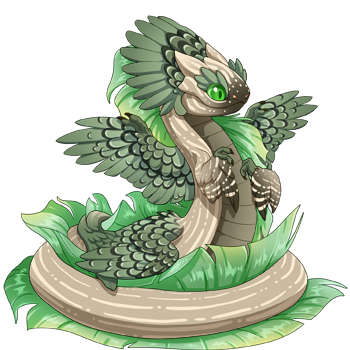
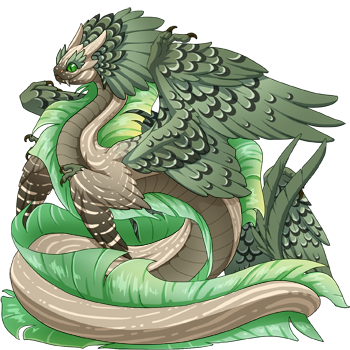
Clutch #3564 - Astelia/Asplenium
Mated On: 2024-04-26
# of eggs: 1
Hatched On: 2024-05-01
Progeny:
Hatchling 9476 (Aspen) - Auraboa Male, Beige Tapir/Algae Edged/Seafoam Sailfin, Common - 15,000 on 2024-05-26
Comments:

#Clutches#Astelia Dragon#Asplenium Dragon#Hatchling#Auraboa Male#Auraboa Breed#Auraboa Hatchling#Tapir#Edged#Sailfin#Beige#Algae#Seafoam#Common
2 notes
·
View notes
Text






Clutch #3498 - Astelia/Asplenium
Mated On: 2024-02-18
# of eggs: 3
Hatched On: 2024-02-23
Progeny:
Hatchling 9311 (Riana) - Auraboa Female, Caramel Tapir/Spruce Stripes/Green Plumage, Common - 15,000 on 2024-03-09
Hatchling 9312 (Bay) - Auraboa Female, Brown Tapir/Spruce Stripes/Peacock Sailfin, Pastel - 15,000 on 2024-03-09
Hatchling 9313 - Auraboa Male, Taupe Varnish/Thicket Stripes/Shamrock Plumage, Common - 15 gems on 2024-03-01
Comments:

#Clutches#Astelia Dragon#Asplenium Dragon#Hatchling#Auraboa Female#Auraboa Male#Auraboa Breed#Auraboa Hatchling#Tapir#Varnish#Stripes#Plumage#Sailfin#Caramel#Spruce#Green#Brown#Peacock#Taupe#Thicket#Shamrock#Common#Pastel
0 notes
Text






Clutch #3435 - Astelia/Asplenium
Mated On: 2023-12-17
# of eggs: 3
Hatched On: 2023-12-22
Progeny:
Hatchling 9138 - Auraboa Female, Slate Varnish/Pistachio Stripes/Emerald Sailfin, Common - 15 gems on 2024-01-09
Hatchling 9139 - Auraboa Female, Slate Tapir/Jungle Stripes/Peacock Plumage, Uncommon - 100,000 on 2023-12-25
Hatchling 9140 - Auraboa Male, Beige Varnish/Emerald Stripes/Green Plumage, Common - 40 gems on 2024-01-03
Comments:

#Clutches#Astelia Dragon#Asplenium Dragon#Hatchling#Auraboa Female#Auraboa Male#Auraboa Breed#Auraboa Hatchling#Varnish#Tapir#Stripes#Sailfin#Plumage#Slate#Pistachio#Emerald#Jungle#Peacock#Beige#Green#Common#Uncommon
1 note
·
View note
Text
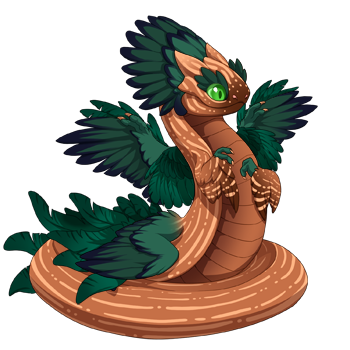
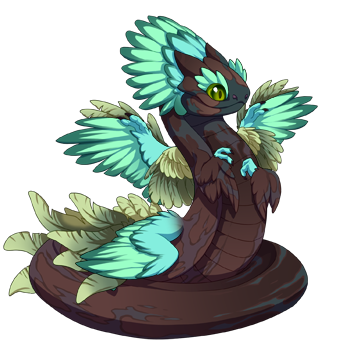
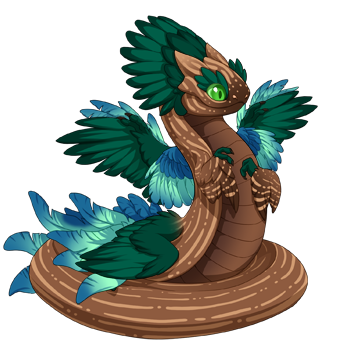
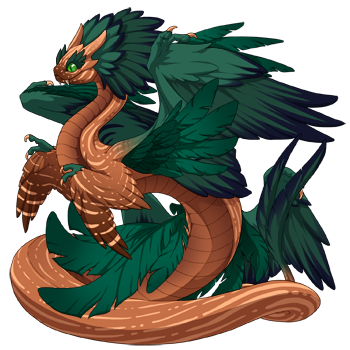
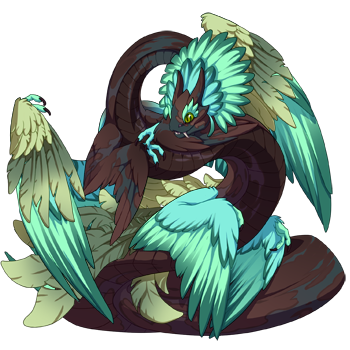

Clutch #3413 - Astelia/Asplenium
Mated On: 2023-11-23
# of eggs: 3
Hatched On: 2023-11-28
Progeny:
Hatchling 9076 - Auraboa Male, Caramel Tapir/Peacock Stripes/Thicket Plumage, Common - 150,000 on 2023-12-06
Hatchling 9077 - Auraboa Female, Clay Varnish/Mint Stripes/Swamp Plumage, Unusual - 300,000 on 2023-11-29
Hatchling 9078 (Arborvita) - Auraboa Male, Brown Tapir/Thicket Stripes/Mint Plumage, Common - 300 gems on 2023-11-29
Comments:
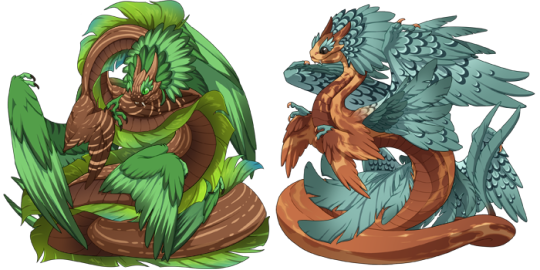
#Clutches#Astelia Dragon#Asplenium Dragon#Hatchling#Tapir#Varnish#Stripes#Plumage#Caramel#Peacock#Thicket#Clay#Mint#Swamp#Brown#Common#Unusual
1 note
·
View note